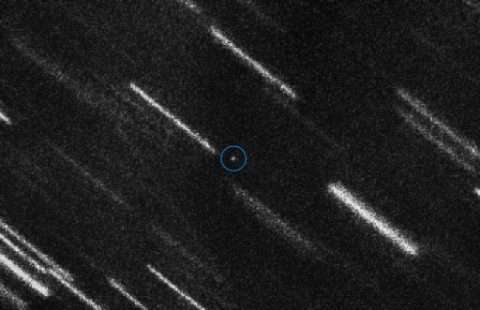
by Mariëtte Le Roux
Agence France Presse
PARIS, France (AFP) — A house-sized asteroid will shave past our planet on October 12, far inside the Moon’s orbit but without posing any threat, astronomers said Thursday.
The space rock will zoom by harmlessly at a distance of about 44,000 kilometers (27,300 miles) — an eighth of the distance from the Earth to the Moon, according to the European Space Agency,
This is just far enough to miss our geostationary satellites orbiting at about 36,000 kilometres.
“We know for sure that there is no possibility for this object to hit the Earth,” Detlef Koschny of ESA’s “Near Earth Objects” research team told AFP.
“There is no danger whatsoever.”
The asteroid, dubbed 2012 TC4, first flitted past our planet in October 2012 — at about double the distance — before disappearing from view.
It is about 15-30 meters (49-98 feet) long, and was travelling at a speed of some 14 kilometers (nine miles) per second when spotted.
Scientists expected the asteroid to return for a near-Earth rendezvous this year, but did not know how close it would get.
Now, the Very Large Telescope of the European Southern Observatory (ESO) in Chile has managed to track the rock down, some 56 million kilometres away, and determine its trajectory.
“It’s damn close,” said Rolf Densing, who heads the European Space Operations Centre in Darmstadt, Germany.
“The farthest satellites are 36,000 kilometres out, so this is indeed a close miss,” he told AFP.
For researchers, the near miss will provide a rare chance to test Earth’s “planetary defense” systems — which at this point are focused on early warning rather than active asteroid deflection.
Not this time
Observing TC4’s movements “is an excellent opportunity to test the international ability to detect and track near-Earth objects and assess our ability to respond together to a real asteroid threat,” said an ESA statement.
Asteroids are rocky bodies left over from the formation of our solar system some 4.5 billion years ago.
There are thought to be millions of them, most of them in a “belt” between the orbits of Mars and Jupiter.
A space rock slightly bigger than TC4, at 40 meters, caused the largest Earth impact in recent history when it exploded over Tunguska, Siberia, in 1908.
In 2013, a meteoroid of about 20 metres exploded in the atmosphere over the city of Chelyabinsk in central Russia with the kinetic energy of about 30 Hiroshima atom bombs.
The resulting shockwave blew out the windows of nearly 5,000 buildings and injured more than 1,200 people. It caught everyone unawares.
If an object the size of TC4 were to enter Earth’s atmosphere, “it would have a similar effect to the Chelyabinsk event,” said the ESA.
But Earth’s atmosphere stretches only a few hundred kilometers far, and TC4 will comfortably miss it. Also, it would likely behave very differently to the Chelyabinsk object.
“The Chelyabinsk meteoroid was a piece of comet and they are usually made of icy material,” said Densing.
“Due to the icy nature it probably dissipated in the atmosphere… When we’re talking about asteroids, this is solid material. They are mostly made up of iron, so will not so easily dissipate their energy in the atmosphere.”
TC4 is unlikely to shed any debris into the atmosphere.
Even if it did, no evacuation would be required for an object this size, said Koschny, merely a warning for people to stay away from windows that could shatter from the shockwave.
Densing, who has previously warned that humanity is not ready to defend itself against an Earth-bound object, said he would not lose any sleep, “not over this one.
“However, it makes you wonder what will happen next time,” he said.
“I would have felt a bit more comfortable if we… had a longer pre-warning time.”
© Agence France-Presse








